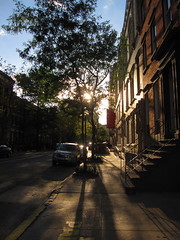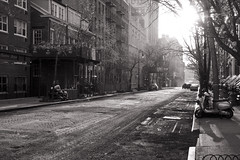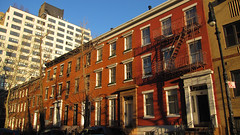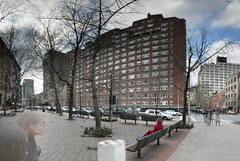South:Site of Richmond HillCorner (160 Varick): Richmond Hill, the colonial mansion that served as a military headquarters for General George Washington and as a residence for both John Adams and Aaron Burr, was moved to this spot when John Jacob Astor bought the estate, leveled the hill and subdivided the property. The mansion became a theater in 1831, which featured the wild animal acts of Isaac Van Amburgh, reputedly the first person to put his head in a lion's mouth. The building was demolished in 1849. The original location of the mansion is in some dispute; some
say it was near this intersection, others place it a block to the west. On this site today is a 12-story commercial building
from 1927 that is home to the
Varick Street Incubator,
an attempt by NYU to foster start-up businesses.
42: This house is the beginning of the Charlton-King-Vandam Historic District, designed to protect this area's fine Federal-style and Greek Revival rowhouses (from the 1820s and 1840s, respectively). Only four of them remain on this side of the block, including this one. In 1872, Tammany politician Michael Norton, who lived here when he was a state senator, lost a diamond stick pin while walking from Charlton to Bleecker, and advertised that he needed it back because "the Senator is a poor man and can ill afford to lose so large a diamond." Elisabeth Irwin High School40: Opened in 1941 as a secondary extension of the Little Red School House, this progressive private school is named for its founder (who also started Little Red), an educational pioneer who worked with John Dewey to create a style of teaching for "the whole child." As Nation editor Victor Navasky (an EIHS graduate) has noted, its alums are a varied lot, including radicals like Angela Davis and Kathy Boudin, neocons Elliott Abrams and Ronald Radosh, and actor Robert DeNiro. The building was put up by the New York City Mission Society as a church for Italian immigrants, the Charlton Street Memorial Church. 30: This building, completed in October 1929 at the very dawn of the Great Depression, replaced Nos. 26-32, buildings once owned by Tammany sachem Amos Cummings, an eight-term congressmember who lived at 32 from 1879 until his death in 1902. Much of Tammany's 8th Ward leadership lived on this block in imitation of Cummings. 26: The building that used to be here was
once owned by Joseph Evans, a member of the nativist Order of
United Americans. Later, in 1921, Katharine Hepburn's brother committed suicide here while visiting their aunt.
24: Singer Paul Robeson lived here in the 1930s and '40s, in one of the few remaining original houses on this side of the block. 20-22: These are also original Federal-style townhouses, and mark the end of the historic district. 2 (corner): This 1966 building replaced Nos. 10-18. 8-10: Was the Saint Raphael Society for the Protection of Italian Immigrants. |
C
|
North:Corner (180 Varick): A 17-story commercial building from 1929 that's home to a number of architectural and design firms, including 2x4, MASS.com, Michael Sorkin Studio/Terreform, Hargreaves Associates, MESH Architectures and Thomas Phifer & Partners. 51-53: These townhouses, now demolished , were turned into an art school and daycare center for the children of Italian immigrants in the early 20th
Century.
43: The Charlton-King-Vandam Historic District begins here on this side of the street, preserving a long string of townhouses that date from the 1820s and 1840s. 39: Along with No. 37 next door, called the best examples of the district's architecture by the AIA Guide. Mary Travers grew up at this address in the 1940s and early '50s. Actor Linda Hunt lived here in the 1980s. 37: This building housed the Monticello
Club, a Tammany clubhouse where patronage was dispensed
and vote fraud was boasted of. In 2004, it was (re)purchased by
Trinity Church to serve as a home for its rector.
29: The Landmarks Commission called this townhouse "a perfect example of the simple 'genteel' house of the Federal period." 25: The Landmarks Commission called this "a rare survivor of its period and neighborhood," complete with stable-turned-residence in the back. Edna Saint-Vincent Millay lived here in 1918, when she wrote many of her best works. 23: Has a striking oval window over its door.
15-21: These houses were built in Greek Revival style after the Federal style originals were destroyed in an 1840 fire. Matthew Broderick and Sarah Jessica Parker lived at No. 17 in the 1990s, moving out in 2002. 11: Once a twin townhouses at 11-13, the buildings were gutted, refaced with tan brick and given an extra story--and a single address. In 1911, before all this, 11 was the home of Daisy Lopez Fitze, a Triangle Shirtwaist Fire victim--she died of injuries suffered when she jumped nine stories into a net. 9 (corner): Last of the block's line of protected rowhouses. The rest of the block was torn down when 6th Avenue was pushed through the South Village. Composer Aaron Copeland lived at this address in 1951--in the rear part, which was once a free-standing carriage house. Actor Fred Gwynne, best known for his Herman Munster character, lived here in the 1980s. 3: Rev. Samuel H. Cox's house at this address was looted by a racist mob on July 10, 1834, outraged by his observation that Jesus "was a colored man." Cox soon moved upstate to teach theology. 1: Clement Clark Moore, who is credited with but probably did not write "A Visit From St. Nicholas," lived at this address with his wife and nine children. Torn down for 6th Avenue. |



